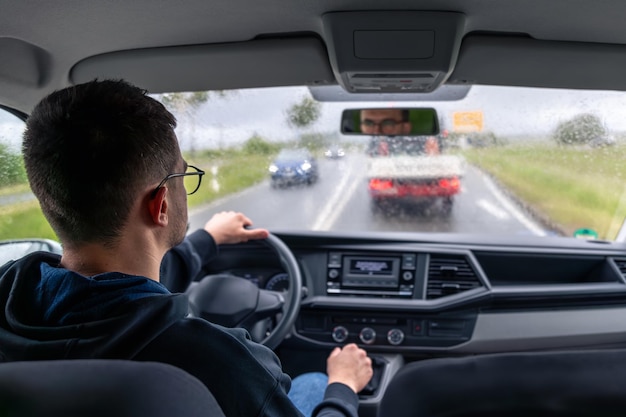

Every second counts on the road. Whether it’s hitting the brakes when a child runs into the street, steering away from an unexpected obstacle, or reacting to a car merging suddenly, your reaction time can mean the difference between a safe drive and a serious accident.
Reaction time—the period between perceiving a hazard and physically responding—is one of the most important factors in safe driving. But here’s the good news: just like muscles, your reflexes can be trained and improved.
In this article, we’ll explore the science behind reaction time, the factors that influence it, and practical ways drivers can sharpen their reflexes for safer driving.
In driving, reaction time refers to how long it takes for you to notice a stimulus (like brake lights ahead) and respond (by pressing the brake pedal). On average, the human brain and body take about 1.5 seconds to react in normal conditions.
This may not sound like much, but consider this:
At 60 mph, a car travels about 88 feet per second.
With a 1.5-second reaction time, you’ve already covered more than 130 feet before even hitting the brakes.
That’s longer than the length of a basketball court—plenty of distance for an accident to occur if you’re not alert.
Not all drivers react at the same speed. Several factors influence how quickly you can respond on the road:
Age – Younger drivers generally have faster reflexes, but experience often balances this advantage. Older adults may notice slower reaction times, especially in stressful driving situations.
Fatigue – Drowsy drivers have significantly delayed responses, similar to the effects of alcohol.
Distractions – Texting, adjusting the radio, or even daydreaming increases the time it takes to react.
Alcohol and Drugs – Even small amounts of alcohol or certain medications impair alertness and reflexes.
Visibility and Weather – Poor lighting, fog, rain, or snow mean hazards are noticed later, effectively extending reaction time.
Stress and Emotions – Anxiety, anger, or road rage can cloud judgment and delay responses.
Psychologists categorize reaction time into different types:
Simple Reaction Time: Responding to one stimulus (e.g., a traffic light turning green).
Choice Reaction Time: Responding to multiple possible events (e.g., deciding whether to brake, steer, or accelerate when a hazard appears).
Complex Reaction Time: Situations requiring rapid decision-making under pressure (e.g., avoiding a skidding car on an icy road).
Driving often involves complex reaction time, which is why training and practice are essential.
The good news is that drivers can improve their reaction times with consistent habits and targeted exercises. Here are effective strategies:
Regular exercise enhances blood flow, coordination, and nervous system efficiency—all of which support faster reflexes. Activities like running, cycling, or swimming improve overall responsiveness.
Sports like table tennis, basketball, or even video games that require fast responses sharpen reflexes. Simulation-based driving games can also mimic road scenarios that train your brain to respond quickly.
Sleep deprivation can slow reaction time by as much as 50%. Aim for at least 7–8 hours of sleep per night to ensure you’re fully alert behind the wheel.
Train yourself to drive with focus:
Keep your phone out of reach.
Avoid eating or multitasking while driving.
Use hands-free technology only when necessary.
By removing distractions, you give your brain more bandwidth to notice hazards quickly.
Taking a defensive driving course or structured lessons like behind-the-wheel training helps you anticipate hazards before they happen. The earlier you predict a situation, the less reaction time you’ll need.
Simple activities like memory games, reaction apps, and puzzle-solving can keep your mind sharp and improve cognitive speed. A sharper brain translates into quicker responses on the road.
Good nutrition, hydration, and avoiding substances that impair focus (like alcohol or sedatives) are essential for peak reflexes. Omega-3 fatty acids, found in fish and nuts, have even been linked to improved brain function.
Improved reflexes don’t just make you a better driver—they make you safer in countless scenarios:
Avoiding collisions when another driver brakes suddenly.
Reacting to pedestrians stepping into the road unexpectedly.
Handling emergencies like tire blowouts or slippery conditions.
Making better split-second decisions during lane changes, merges, or turns.
Faster reaction time also contributes to confidence behind the wheel, reducing hesitation and anxiety during challenging situations.
Driving is as much a mental game as it is a physical one. While vehicles continue to advance with technologies like automatic braking and collision alerts, nothing replaces the importance of a driver’s quick thinking and reflexes.
By understanding the science of reaction time and practicing ways to improve it, every driver can make the road a safer place—for themselves, their passengers, and everyone around them.
Your brain and body can be trained. Better reflexes mean better decisions, and better decisions save lives.
92 Main Street WoodBridge, New Jersey 07095 USA
techdrivingschool [ @ ] gmail.com
7327504455
#000048
